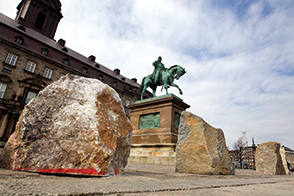Published: 21-12-2017
We need to focus more on security when we implement anti-terrorism measures. Additionally, we need to be better at taking advantage of experiences from abroad when it comes to implementing anti-terrorism measures.
The politicians and employees at the Danish parliament, Christiansborg, are an obvious target for terrorism, and therefore work has begun on securing the area around the Christiansborg Palace Square. After several years of negotiations, it has been decided that a number of temporary granite slabs are to be replaced with granite spheres, 112 cm in diameter, in order to prevent unauthorised vehicles from entering the palace square.
The appearance and expression of the anti-terrorism measures within and around the historic Christiansborg Palace has been the subject of an intense debate, and the design considerations have been one of the reasons why permanent anti-terrorism measures have taken a number of years to implement. But the debate concerning design in relation to anti-terrorism measures reduces their effectiveness in the opinion of Jesper Florin, the head of the security department at DBI, the Danish Institute of Fire and Security Technology.
- We have to think about a lot more than the extent to which granite spheres may be suitable for the Christiansborg Palace Square or not. Terrorism is a growing problem everywhere, and therefore we need to be better at listening to the experiences of the neighbouring countries that have unfortunately already been exposed to terrorist attacks, says Jesper Florin.
Need for a national agency
Jesper Florin thinks that Denmark should gather all the agencies that possess important knowledge about terrorism, defence and security in order to be able to give the best possible advice and develop the best solutions. This could be the police, the PET (police intelligence service), the armed forces, the security industry and, of course, the city planners.
- Among others, we have the military with a lot of experience, and also the police intelligence service who collect knowledge from all around the world. Why don't we set up a national knowledge centre for anti-terrorism measures where all knowledge is gathered in one place to the benefit of both Denmark and our partner countries? Jesper Florin asks.
Both secure and easy on the eyes
According to Jesper Florin, a national knowledge centre against terrorism could lead to more perspectives being available for more thoroughly considered anti-terrorism measures, and where the effectiveness is not necessarily an either/or when it comes to the trade-off between security and design or appearance.
- Take a look at Oslo, for example. Here, they have begun securing the entire government district by, among other things, using urban open spaces and architecture. It is effective and easy on the eyes at the same time, so it is in fact possible to reconcile security with nice design, says Jesper Florin.
In Oslo, a series of architectural and design-related elements have been merged as security elements over a larger area. Thus, flower boxes, scenic elevations of terrain, water basins and winding streets all serve as anti-terrorism measures that prevent vehicles from gaining unauthorised access to the area.
- With the terror attack of 2011, the Norwegians saw how much can go wrong, so they are determined to make adaptations. The same way, I am sure, that we would adapt to changes in Denmark, Jesper Florin says.
In Oslo, it is not just a single historic building that has been secured. Here, they have made a thorough plan that focuses on the entire government zone.
- If we are to reach the same level of security in Denmark, then it will require an increased level of cooperation between the authorities, police and private stakeholders working with security and planning, Jesper Florin points out.
